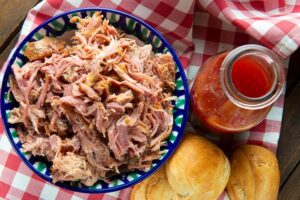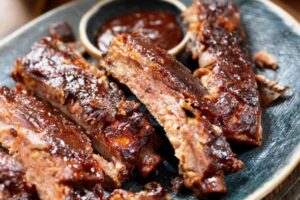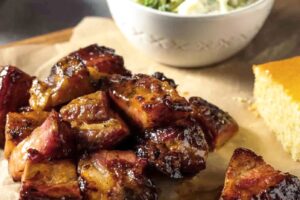As we just had lovely weather this weekend (and it looks like we might have more happening more frequently over the next couple of weeks, grill covers are being removed and Brits are starting to talk of BBQ.

Here’s the thing though. When they say BBQ – they mean grilling. They don’t mean BBQ in the sense that many Americans means BBQ (the cooking of meat for long periods of time at low temperatures with smoke from a wood fire).
Don’t get me wrong, I’m a fan of grilling. But it isn’t BBQ just because you use the grill. BBQ is a multi-faceted, often-debated, regionally varied thing in the States. Of course, it will necessarily follow that laying out my views on what each style is and means, others will have differing views and won’t hesitate to share them.
That’s fine. It’s a big broad, barbecue-y world – and I did mention ‘often-debated.’
There’s Carolina barbecue …

… which is usually pork, served pulled, shredded, or chopped, but sometimes sliced. It may also be rubbed with a spice mixture before smoking and mopped with a spice and vinegar liquid during smoking. The wood used is usually oak or hickory. Carolina barbecue sauce is not the sweet stuff you are used to finding in jars across the supermarket shelves. Nope, this is tangy, not sweet (it’s the vinegar).
When we talk of Memphis barbecue …

… we are generally talking about ribs (“wet” or “dry”) or chopped pork barbecue sandwiches. Wet ribs are brushed with sauce before and after cooking, while dry ribs are – as you might have guessed – seasoned with a dry rub. The barbecue sandwiches are generally on a simple bun (nothing artisan or fussy) and topped with barbecue sauce (which will be a secret recipe that no one will reveal on pain of visits from ghostly ancestors).
Why is Kansas City style BBQ…

… the one most people picture in their head when they hear the word ‘barbecue?’ Probably because it can involve almost any protein found in any of the other regional variations – beef, pork, and lamb, even fish. And because the Kansas style sauce is higher profile globally than Carolina. And really, the star of the show in Kansas is the sauce (again, usually a closely guarded recipe).
But the sauce is not – as it is in Carolina style – used during cooking. The meat is smoked with a dry rub and the sauce stands on its own, used as a condiment and served at the table. Kansas style barbecue sauce is much sweeter than Carolina style. It may have a tang to it (the best ones do) but it’s far sweeter and again, likely the thing most people imagine when they hear the phrase barbecue sauce.

The other constant in Kansas City BBQ is burnt ends. Oh my… those are the BEST. These are not scorched, though the name might give that impression. Don’t go thinking you’re gonna get something that tastes like charcoal. These are the trimmings of smoked brisket, the tough stuff – but it’s been slow-cooked, caramelized and has gone from tough to mouthwatering and tender.
Texas style is…

… well, it’s layered and broad, complicated and takes so many cues from so many influences (geographic and historic) that I could write something three times as long just on this one style alone. So, it makes sense given the size of the state, the different groups that settled in different areas and other factors – that its regional BBQ style has several sub-regional styles. That said, you see sausages more commonly in Texas BBQ overall that in other areas (maybe because of the high level of German immigration to central Texas via Galveston?)
- Central Texas style: This is a dry rub style – and the rub is traditionally just salt and pepper (personalised by proportions) but with time and the melding of influences, some use other spices as well. Sauce is not a thing in this style, so you don’t see quite the hysteria over long held family recipes being handed down to eldest children etc, etc. It’ll come with a couple of slices of white bread and sauce on the side or on the table should it be needed.
- In East Texas, it’s beef and it’s cooked slow. Very slow. Slow, slow, slow until it’s falling off the bone. Flavour profile is created by hickory wood (traditionally but not exclusively) and a sweet, tomato-based sauce.
- West Texas style: this is direct heat (and a high heat) over mesquite, coming out of the cowboy cattle drive style of cooking
- Southern Texas style: The meat in this style isn’t so much marinated as suspended in a very thick, molasses-like sauce. The thickness of the sauce is what keeps the meat from drying out.
And I haven’t even touched on the Mexican influenced barbacoa-style in the Rio Grande Valley yet. That’ll be for part two (because there’s a lot of Texas and lots of other regional styles from the Western US to get to as well).
Anyway, just something I kept meaning to expound on every time the grilling season heats up here in the UK. Glad I finally got something written down.
